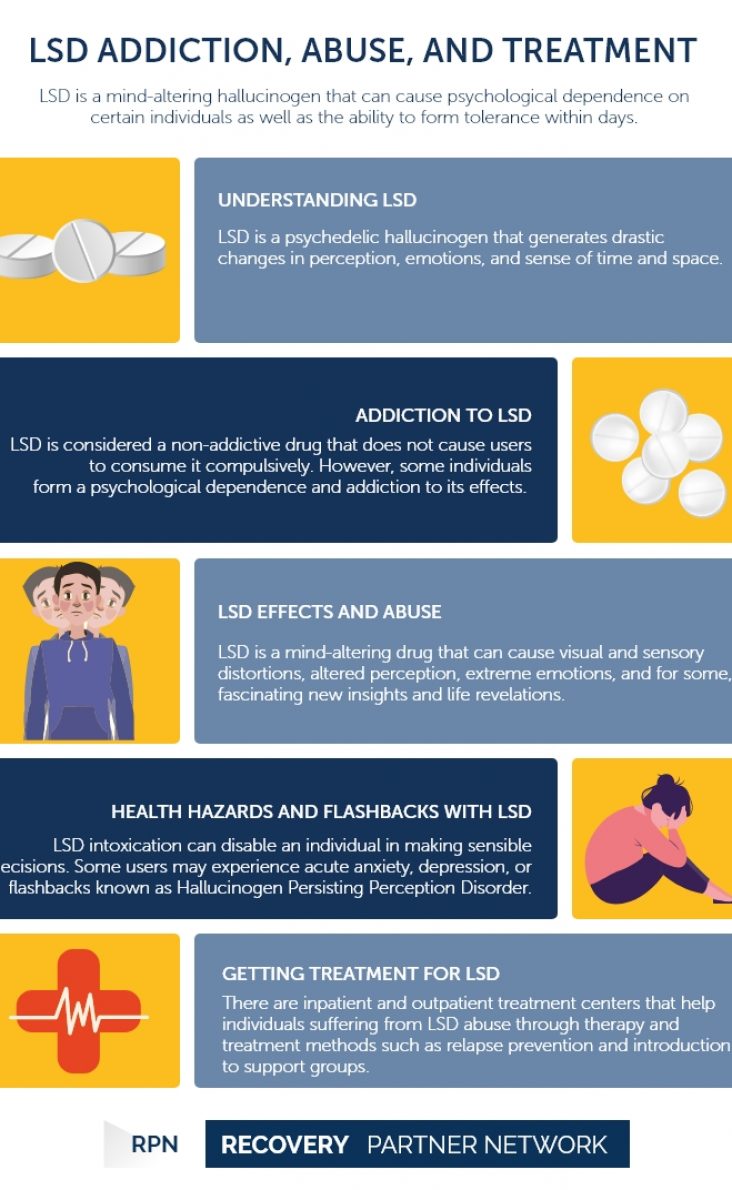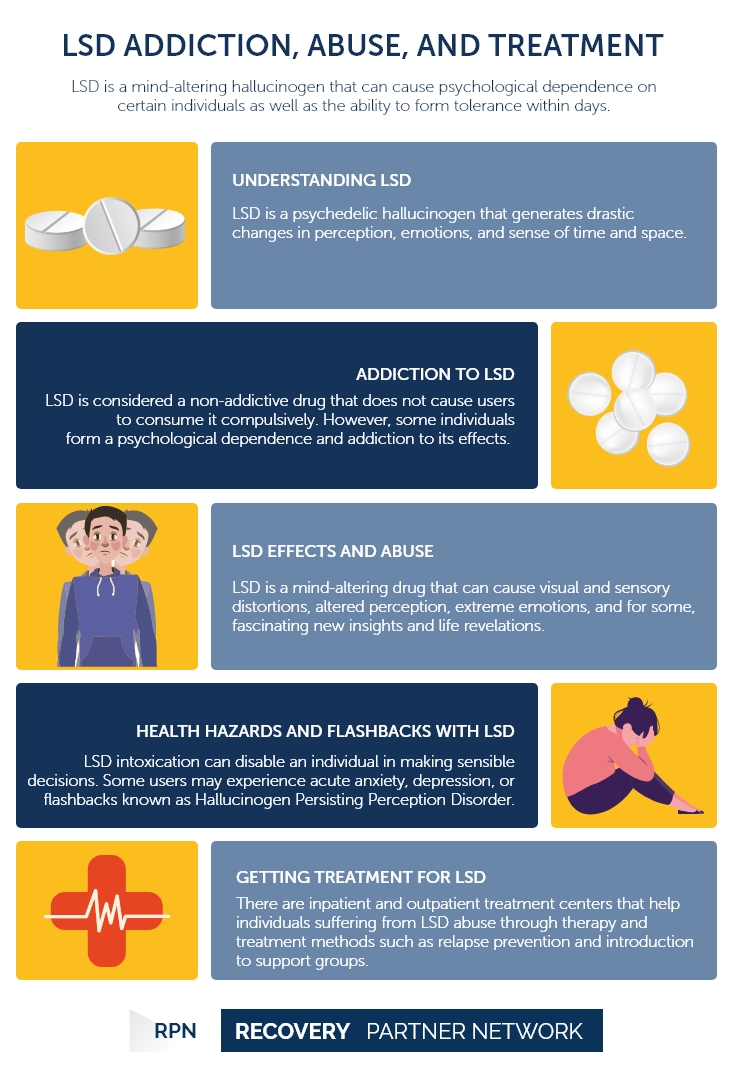LSD is a mind-altering hallucinogen that can cause psychological dependence on certain individuals as well as the ability to form tolerance within days.
LSD Addiction, Abuse, and Treatment
Illicit drugs
- Ayahuasca addiction – Abuse
- Baclofen addiction
- Black tar heroin addiction
- Cannabis addiction
- Cocaine dependence
- Crack cocaine addiction
- DMT addiction abuse treatment
- Does Marijuana Kill Brain Cells?
- Ecstasy addiction
- Gabapentin addiction
- gamma-Hydroxybutyric acid addiction
- Hallucinogen
- Heroin addiction
- Illicit drug addiction
- Inhalant addiction
- Cocaine
- Ketamine addiction
- Lysergic acid diethylamide addiction
- Mescaline addiction
- Methamphetamine addiction
- Meth Labs: Cooking up Addiction
- Meth Mouth
- Microdosing
- Phencyclidine addiction
- Psilocybin mushroom addiction
- Sage of the diviners – Addiction
- Shooting Heroin
- Shooting Methamphetamine
- Smoking Cannabis
- Speedball
- Synthetic cannabinoids
Lysergic acid diethylamide addiction | Table of Contents
Understanding LSD
Lysergic acid diethylamide, commonly known as acid or LSD, is a psychedelic hallucinogen that generates drastic changes in perception, emotions, and sense of time and space. LSD was first synthesized in 1938 from a compound known as lysergic acid, which is found in ergot, a naturally occurring fungus.
LSD is initially produced in crystalline form, which is then combined with other inactive ingredients or diluted into liquid solutions. It is a colorless, odorless, and bitter-tasting drug. LSD is generally active at small doses of 20 micrograms and is consumed orally in the forms of tablets, droplets, or blotter papers that are absorbed onto the tongue and then swallowed.
LSD is classified as a Schedule I Substance under the Controlled Substance Act, which is by far the most criminalized category for drugs as they are regarded to hold high potential for abuse with no legitimate medical use. However, new research has uncovered LSD’s potential to treat depression, anxiety, PTSD, and addiction. Although LSD affects everyone differently, it also carries the potential to cause adverse physical and psychological effects.
FAQ
LSD, also known as acid, is a synthetic hallucinogen that can induce hallucinations and cause an individual to experience profound mind-altering changes in consciousness and perception.
LSD is a colorless and odorless substance with a bitter taste, mostly found in saturated blotter paper, which is divided into squares. Each square equates to one dose. It is also available in saturated sugar cubes, tablets, or in liquid form.
Addiction to LSD
LSD is considered a non-addictive drug that does not cause users to consume it compulsively. However, some individuals do find themselves addicted to the sights, sounds, and revelations experienced while “tripping.” Users can quickly build up a tolerance to the drug as well as psychological dependence on psychedelics like LSD. Documented cases have also indicated that prolonged, heavy use of LSD can pave the way for negative side effects such as paranoia or psychosis.
FAQ
LSD is a Schedule I substance under the Controlled Substances Act and is illegal to be sold or purchased.
LSD Effects and Abuse
LSD is known for its ability to create profound changes in consciousness and perception. It is a mind-altering drug that can cause visual and sensory distortions, altered perception, extreme emotions, and for some, fascinating new insights and life revelations. The effects of LSD generally last for eight to ten hours, with peak effects taking root four to six hours after consumption. It can take around 24 hours for a user to regain normalcy.
As LSD is most commonly consumed through blotter papers, it is quite difficult to independently evaluate the average dose. This issue is further compounded by the fact that different individuals tend to react differently to LSD. It is crucial to acknowledge that consuming too much of LSD can result in feelings of disassociation and alienation. LSD is sold under many street names such as Blotter, Doses, Dots, Trips, Mellow Yellow, Window Pane, and Purple Dragon.
The hallucinogenic effects of LSD functions by interacting with the serotonin receptors in the brain, which are responsible for controlling behaviors, moods, senses, and thought processes.
The common side effects of LSD are:
- Delusions
- Sensory enhancement
- Sweating
- Alienation
- Dry mouth
- Hallucinations
- Tremors
- Synesthesia (hearing colors or seeing sounds)
- Dissociation
- Anxiety
- Impaired depth perception
- Panic attacks
- Flashbacks
- Depression
Tolerance to LSD is formed rapidly within three days of consecutively consuming the drug. Users who regularly abuse the drug will have to progressively take higher doses of the drug to attain the same state of intoxication that was initially achieved. This practice is quite dangerous, as increased dosages can lead to adverse psychological side effects as well as higher chances of experiencing a “bad trip.”
The risk of overdose is surprisingly rare with LSD, and the risk of a fatal overdose is virtually nonexistent. However, LSD still remains unsafe as it can cause risky behaviors and side effects. As some trips can last for 12 hours or more, users may experience low inhibition or act out due to hallucinations during that period. This may lead to destructive actions and injuries, along with social, legal, and professional consequences. LSD is also lethal when combined with other drugs, especially with anti-depressants such as lithium. The most severe effects of LSD are likely to occur after frequent and heavy doses.
The effects of prolonged, heavy use of LSD may include:
- Hyperthermia
- Suicidal thoughts
- Psychosis
- Seizures
- Increase in blood sugar
- Insomnia
- Tremors
- Nausea
- Loss of appetite
FAQ
There is no age range for LSD use. An estimated number of 20.2 million individuals age twelve and older in the United States have used LSD at least once in their lifetime, according to the National Household Survey on Drug Abuse.
LSD can cause an individual to experience anxiety, depression, flashbacks, and elevated blood pressure. The unpredictable nature of LSD can also cause some users to experience terrifying thoughts, feelings of despair, fear of losing control, fear of insanity, and fear of death during a bad trip. Prolonged consumption can lead to psychosis, seizures, hyperthermia, and suicidal thoughts.
Health Hazards and Flashbacks with LSD
LSD intoxication can disable an individual to make sensible decisions and to sense oncoming dangers, making the user susceptible to personal injuries and even death. After an LSD trip, users may experience acute anxiety, depression, or flashbacks known as Hallucinogen Persisting Perception Disorder (HPPD).
Flashbacks are the recurrences of the LSD effects days or even months after the last dose. Flashbacks transpire suddenly, oftentimes without the slightest warning, in individuals who consume hallucinogens regularly or have an underlying personality problem. Healthy individuals who take LSD occasionally may also experience flashbacks.
LSD users may also exhibit signs of long-lasting psychosis, such as schizophrenia or chronic depression, after prolonged heavy consumption of LSD.
LSD Abuse Statistics
- A study in 2008 has discovered that 3.1 million Americans between 12 to 25 years of age have experimented with LSD.
- The “Monitoring the Future (MTF)” study has analyzed that 1.6 percent of eighth-graders in 2019 have indulged in LSD at least once in their lifetime. ·
- The 2014 Global Drug Survey (GDS) has assessed that 27.22 percent of Americans who consumed LSD have experienced a “bad trip.”
- Rates of LSD use remain low among American youths. In 2018, reports indicated that around 376,000 adolescents (3.5 percent) aged 12 to 17 used hallucinogens within the past year. This percentage was significantly lower compared to the rates in 2015 and 2017.
- Based on the data derived from NIDA’s Monitoring the future 2019 Survey results: Overall Findings, the previous year’s illicit LSD use amongst the surveyed 12th graders was 3.6 percent, which was far below the percentage of marijuana use that stood at 35.7 percent.
Getting Treatment for LSD
There are many inpatient and outpatient treatment centers available to help individuals suffering from LSD abuse. The many types of therapies offered by these centers, such as dialectical behavioral therapy, cognitive-behavioral therapy, and lifestyle skills therapy, have proven to help break the formation of hallucinogenic dependency. In addition, treatment methods such as relapse prevention and introduction to support groups such as Narcotics Anonymous (NA) are all highly effective tools for prolonged recovery. Similar to any form of addiction treatment, ongoing therapy and aftercare programs can also play a significant role in preventing relapses in the long run.
Recovery Partner Network
We aim to educate and empower. If you feel our library of resources does not cover your specific need, reach out to us, and we would be happy to help.
STATISTICS
© Copyright 2025


